Tetraoctagonal tiling
| Tetraoctagonal tiling | |
|---|---|
 Poincaré disk model of the hyperbolic plane | |
| Type | Hyperbolic uniform tiling |
| Vertex figure | 4.8.4.8 |
| Schläfli symbol | r{8,4} rr{8,8} rr(4,4,4) t0,1,2,3{(∞,4,∞,4)} |
| Wythoff symbol | 2 | 8 4 |
| Coxeter diagram | |
| Symmetry group | [8,4], (*842) [8,8], (*882) [(4,4,4)], (*444) [(∞,4,∞,4)], (*4242) |
| Dual | Order-8-4 quasiregular rhombic tiling |
| Properties | Vertex-transitive edge-transitive |
In geometry, the tetraoctagonal tiling is a uniform tiling of the hyperbolic plane.
Constructions
There are for uniform constructions of this tiling, three of them as constructed by mirror removal from the [8,4] or (*842) orbifold symmetry. Removing the miror between the order 2 and 4 points, [8,4,1+], gives [8,8], (*882). Removing the mirror between the order 2 and 8 points, [1+,8,4], gives [(4,4,4)], (*444). Removing both mirrors, [1+,8,4,1+], leaves a rectangular fundamental domain, [(∞,4,∞,4)], (*4242).
| Name | Tetraoctagonal tiling | Rhombioctaoctagonal tiling | ||
|---|---|---|---|---|
| Image |  |
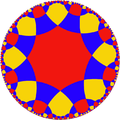 |
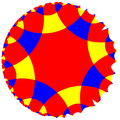 |
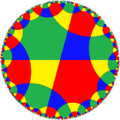 |
| Symmetry | [8,4] (*842) |
[8,8] = [8,4,1+] (*882) |
[(4,4,4)] = [1+,8,4] (*444) |
[(∞,4,∞,4)] = [1+,8,4,1+] (*4242) |
| Schläfli symbol | r{8,4} | rr{8,8} | r(4,4,4) | t0,1,2,3(∞,4,∞,4) |
| Coxeter diagram |
Symmetry
The dual tiling has face configuration V4.8.4.8, and represents the fundamental domains of a quadrilateral kaleidoscope, orbifold (*4242), shown here. Adding a 2-fold gyration point at the center of each rhombi defines a (2*42) orbifold.
 |
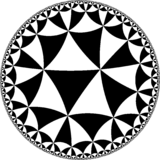 |
Related polyhedra and tiling
| Symmetry *4n2 [n,4] |
Spherical | Euclidean | Compact hyperbolic | Paracompact | Noncompact | |||
|---|---|---|---|---|---|---|---|---|
| *342 [3,4] |
*442 [4,4] |
*542 [5,4] |
*642 [6,4] |
*742 [7,4] |
*842 [8,4]... |
*∞42 [∞,4] |
[iπ/λ,4] | |
| Coxeter | ||||||||
| Quasiregular figures configuration |
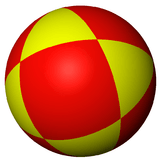 4.3.4.3 |
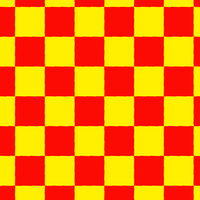 4.4.4.4 |
 4.5.4.5 |
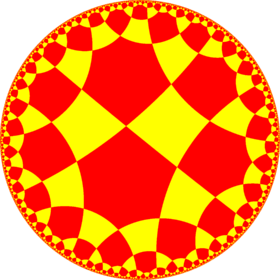 4.6.4.6 |
 4.7.4.7 |
 4.8.4.8 |
 4.∞.4.∞ |
4.∞.4.∞ |
| Dual figures | ||||||||
| Coxeter | ||||||||
| Dual (rhombic) figures configuration |
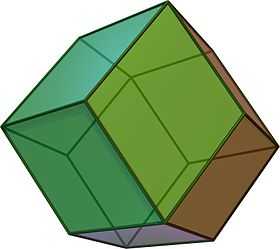 V4.3.4.3 |
 V4.4.4.4 |
 V4.5.4.5 |
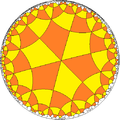 V4.6.4.6 |
 V4.7.4.7 |
 V4.8.4.8 |
 V4.∞.4.∞ |
V4.∞.4.∞ |
| Symmetry *8n2 [n,8] |
Hyperbolic... | Paracompact | Noncompact | |||||
|---|---|---|---|---|---|---|---|---|
| *832 [3,8] |
*842 [4,8] |
*852 [5,8] |
*862 [6,8] |
*872 [7,8] |
*882 [8,8]... |
*∞82 [∞,8] |
[iπ/λ,8] | |
| Coxeter | ||||||||
| Quasiregular figures configuration |
 3.8.3.8 |
 4.8.4.8 |
 8.5.8.5 |
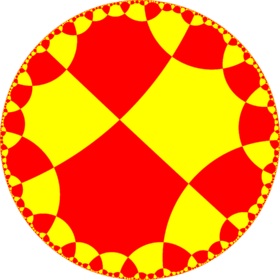 8.6.8.6 |
 8.7.8.7 |
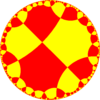 8.8.8.8 |
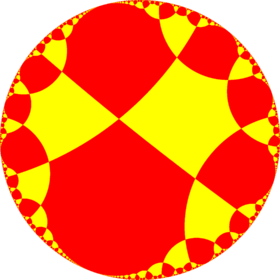 8.∞.8.∞ |
8.∞.8.∞ |
| [8,4], (*842) (with [8,8] (*882), [(4,4,4)] (*444) , [∞,4,∞] (*4222) index 2 subsymmetries) (And [(∞,4,∞,4)] (*4242) index 4 subsymmetry) | ||||||
|---|---|---|---|---|---|---|
= = = |
= |
= = = |
= |
= = |
= |
|
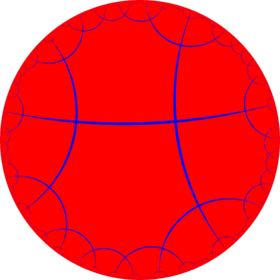 |
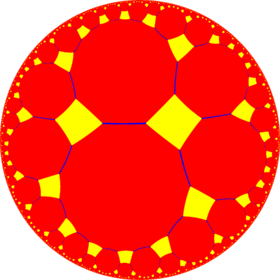 |
 |
 |
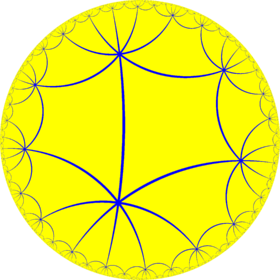 |
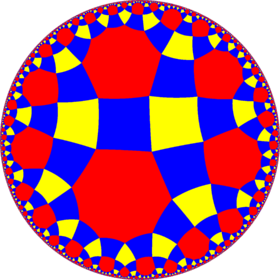 |
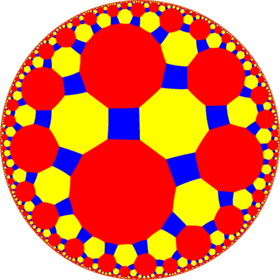 |
| {8,4} | t{8,4} |
r{8,4} | 2t{8,4}=t{4,8} | 2r{8,4}={4,8} | rr{8,4} | tr{8,4} |
| Uniform duals | ||||||
 |
 |
 |
 |
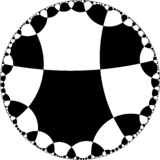 |
 |
 |
| V84 | V4.16.16 | V(4.8)2 | V8.8.8 | V48 | V4.4.4.8 | V4.8.16 |
| Alternations | ||||||
| [1+,8,4] (*444) |
[8+,4] (8*2) |
[8,1+,4] (*4222) |
[8,4+] (4*4) |
[8,4,1+] (*882) |
[(8,4,2+)] (2*42) |
[8,4]+ (842) |
= |
= |
= |
= |
= |
= |
|
 |
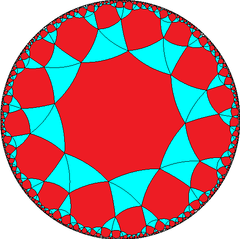 |
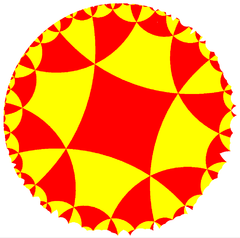 |
 |
 |
 |
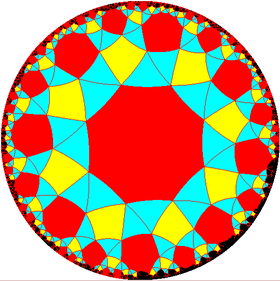 |
| h{8,4} | s{8,4} | hr{8,4} | s{4,8} | h{4,8} | hrr{8,4} | sr{8,4} |
| Alternation duals | ||||||
 |
 |
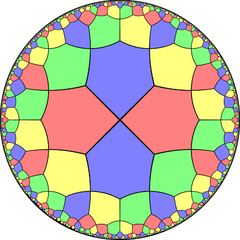 |
 |
 |
||
| V(4.4)4 | V3.(3.8)2 | V(4.4.4)2 | V(3.4)3 | V88 | V4.44 | V3.3.4.3.8 |
| Symmetry: [8,8], (*882) | |||||||||||
|---|---|---|---|---|---|---|---|---|---|---|---|
= |
= |
= |
= |
= |
= |
= | |||||
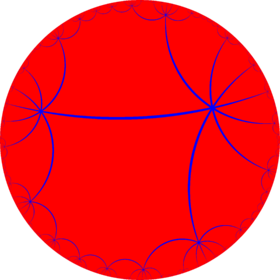 |
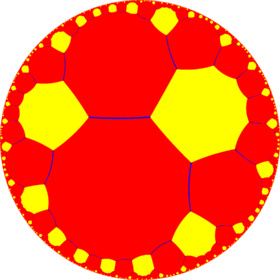 |
 |
 |
 |
 |
 | |||||
| {8,8} | t{8,8} |
r{8,8} | 2t{8,8}=t{8,8} | 2r{8,8}={8,8} | rr{8,8} | tr{8,8} | |||||
| Uniform duals | |||||||||||
 |
 |
 |
 |
 |
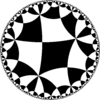 |
 | |||||
| V88 | V8.16.16 | V8.8.8.8 | V8.16.16 | V88 | V4.8.4.8 | V4.16.16 | |||||
| Alternations | |||||||||||
| [1+,8,8] (*884) |
[8+,8] (8*4) |
[8,1+,8] (*4242) |
[8,8+] (8*4) |
[8,8,1+] (*884) |
[(8,8,2+)] (2*44) |
[8,8]+ (882) | |||||
= |
= | ||||||||||
 |
 |
 |
 |
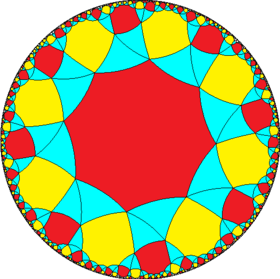 | |||||||
| h{8,8} | s{8,8} | hr{8,8} | s{8,8} | h{8,8} | hrr{8,8} | sr{8,8} | |||||
| Alternation duals | |||||||||||
 |
 |
||||||||||
| V(4.8)8 | V3.4.3.8.3.8 | V(4.4)4 | V3.4.3.8.3.8 | V(4.8)8 | V46 | V3.3.8.3.8 | |||||
| Symmetry: [(4,4,4)], (*444) | [(4,4,4)]+ (444) |
[(1+,4,4,4)] (*4242) |
[(4+,4,4)] (4*22) | ||||||
|---|---|---|---|---|---|---|---|---|---|
 |
 |
 |
 |
 |
 |
 |
 |
 |
 |
| t0{(4,4,4)} | t0,1{(4,4,4)} | t1{(4,4,4)} | t1,2{(4,4,4)} | t2{(4,4,4)} | t0,2{(4,4,4)} | t0,1,2{(4,4,4)} | s{(4,4,4)} | h{(4,4,4)} | hr{(4,4,4)} |
| Uniform duals | |||||||||
 |
 |
 |
 |
 |
 |
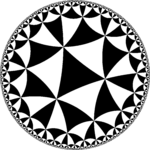 |
 |
 |
 |
| V(4.4)4 | V4.8.4.8 | V(4.4)4 | V4.8.4.8 | V(4.4)4 | V4.8.4.8 | V8.8.8 | V3.4.3.4.3.4 | V88 | V(4,4)3 |
See also
| Wikimedia Commons has media related to Uniform tiling 4-8-4-8. |
- Square tiling
- Tilings of regular polygons
- List of uniform planar tilings
- List of regular polytopes
References
- John H. Conway, Heidi Burgiel, Chaim Goodman-Strass, The Symmetries of Things 2008, ISBN 978-1-56881-220-5 (Chapter 19, The Hyperbolic Archimedean Tessellations)
- "Chapter 10: Regular honeycombs in hyperbolic space". The Beauty of Geometry: Twelve Essays. Dover Publications. 1999. ISBN 0-486-40919-8. LCCN 99035678.